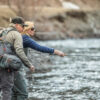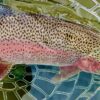Synopsis
As summertime in the Rockies slowly drifts toward fall, fishing in the Wood River Valley region offers some great opportunities. With fly-fishing reaching its summer peak, there is something for every angler, even if you prefer bouncing large terrestrials off the bank on stout tippet or downstream drifting tiny mayflies into the jaws of risers. The inconsistency of our local weather has presented us all with some challenging conditions this year, but throwing a rain slicker or fleece jacket in the trunk just might be what helps you endure while others leave the river for home.
Big Wood River
The Big Wood has fallen into its predictable August pattern. At 276cfs, strong morning fishing is generally followed by less productive afternoons which eventually leads to exciting evenings. As the month continues, we will see a solid representation of Trico as well as Baetis in the early mornings. Sipping fish will be seen in the slow water as well as along seams where the faster current parallels calmer water. Microcaddis, which generally emerges in the evenings and after dusk, will be present in good numbers in the morning as well as a scattering of larger Pink Alberts. In addition to these patterns, be sure to keep a few Rusty Spinners in your box for the sporadic mayfly spinner falls. As the daytime high temperatures near, expect to see smaller fish splashing on the surface as they forage. A variety of Grasshopper patterns will give the afternoon angler an excellent chance at larger rainbows with the addition of droppers such as brown mayfly nymphs or Caddis Pupae upping the number of hookups. In the evening look for a few larger mayflies intermixing with a significant Caddis emergence. Generally, any number of Caddis patterns work well here, especially if they are small (size 18) and offered in shades of beige.
Silver Creek
Trico Madness has arrived! As is the case every August, Silver Creek is in the heat of the Trico spinner fall as a concurrent Baetis emergence and PMD spinner fall complete the menu. August on Silver Creek means waking at the brink of dawn and making the morning pilgrimage to these tranquil, steely spring creek waters as clouds of Tricos will begin to appear at about 7:30 am. It is wise to begin your approach with Trico Duns as the small black and white mayflies enjoy their last vibrant moments before mating, dropping their eggs and falling lifelessly to the water’s surface. As the morning continues, do not be blinded by the Tricos alone. Look closely at your waders you’ll notice a large numbers of Baetis crawling up your legs. Although particular fish will often be taking these petite olive brown mayflies, know that most rainbows and browns will still be focused on the Tricos. The key to success here is presenting the fly downstream without drag. Short parachute casts followed by releasing slack and straightening the line by lifting the rod tip can result in some spectacular fishing. Make sure to allow the fly to float up to and past targeted fish so that fish will not associate any disturbance created by removing the fly with the specific pattern you are presenting. Near the climax of the morning mayfly action, pay close attention to the surrounding bugs as PMDs start to appear, sometimes only for short periods of time, which can bring even the most wary fish to the surface. More aggressive, splashier rises will be a hint to this development. Working through a rotation of four or five fly patterns is recommended as savvier fish come to recognize imitations quite quickly, sometimes after just a handful of drifts.
Afternoon fishing on the creek is most productively executed by the use of terrestrials such as grasshoppers and beetles fished close to the banks. Remember to re-rig your setup with much stronger tippet such as 3x or 4x since the fish are most regularly coming out from under the banks and will not see your leader. You can even try walking down the center of the stream casting to one bank and then the other, searching for that aggressive carnivorous brown or rainbow that has been waiting for a large and vulnerable meal.
Evening fishing on the Creek generally offers smaller angling crowds than the morning. Look for a hodgepodge of mayflies including PMDs as well as Caddis which can bring fish aggressively to the surface as the temperatures cool. As darkness falls, increase the size of your tippet and consider throwing mouse patterns near the banks.
Big Lost River
The stream flow below the dam has been lowered to approximately 450cfs which makes walk and wade fishing possible, although it can still be too heavy of a stream flow for many casual anglers. For those who wish to visit the Valley of a Thousand Springs, be outfitted with a variety of brown mayfly nymphs sizes 12-16 as well as standard mayfly dun patterns such as the Parachute Adams as well as cranefly patterns. Craneflies can produce exciting fishing as rainbows come to the surface vigorously in their attempt to snag these highly mobile meals. It is important to skate these patterns on the water as dead-drifted imitations tend to be far less productive. Maroon wooly buggers can often entice the colorful Kokanee sockeye to bite, as well as the large rainbows that follow them on their annual spawning run. Expect the flow of the Big Lost to lower as the summer continues, eventually resulting in some spectacular fishing opportunities into the fall.
Upper Big Lost / Copper Basin
The Basin and its surrounding tributaries are fishing exceptionally well. Insects vary in size from the diminutive Trico, to larger PMDs, to the ubiquitous grasshopper. Also, be equipped with black flying ants. Cuttbows have grown in number over the past couple years which, when added to the numerous wild brook trout and rainbows, create the opportunity to hook five different species of trout in one day! It is important to release all whitefish unharmed as soon as possible as this unique strain has become threatened in recent years. Fly selection is less important here when compared to other local waters. Hoppers and Parachute Adams as well as flying ants and general attractor patterns will work very effectively here into the late afternoon and evening. Although fishing with droppers is certainly an effective technique, this is a great opportunity to fish large dry flies alone, which can make for very good fishing even for the less experienced angler.
South Fork of the Boise
At 1800cfs, the South Fork of the Boise is still best fished from a drift boat. Caddis and Pink Alberts are most likely to take fish in addition to hoppers thrown near the bank. As always, streamer patterns can produce some massive hits as trophy rainbow and bull trout lurk hungrily in the depths. Immediate release of bull trout is mandatory, so be vigilant as to the species of fish hooked, especially if it is a whopper!
Alpine Lakes
The local alpine lakes are fishing wonderfully with spectacular midge hatches both in the evenings and early mornings. Black flying ants and grasshoppers tend to appear in significant numbers in August and fish will come to these patterns even from great depths. Using attractor patterns with droppers along shorelines as well as near inlet and outlet streams is an excellent way to entice the fish.



